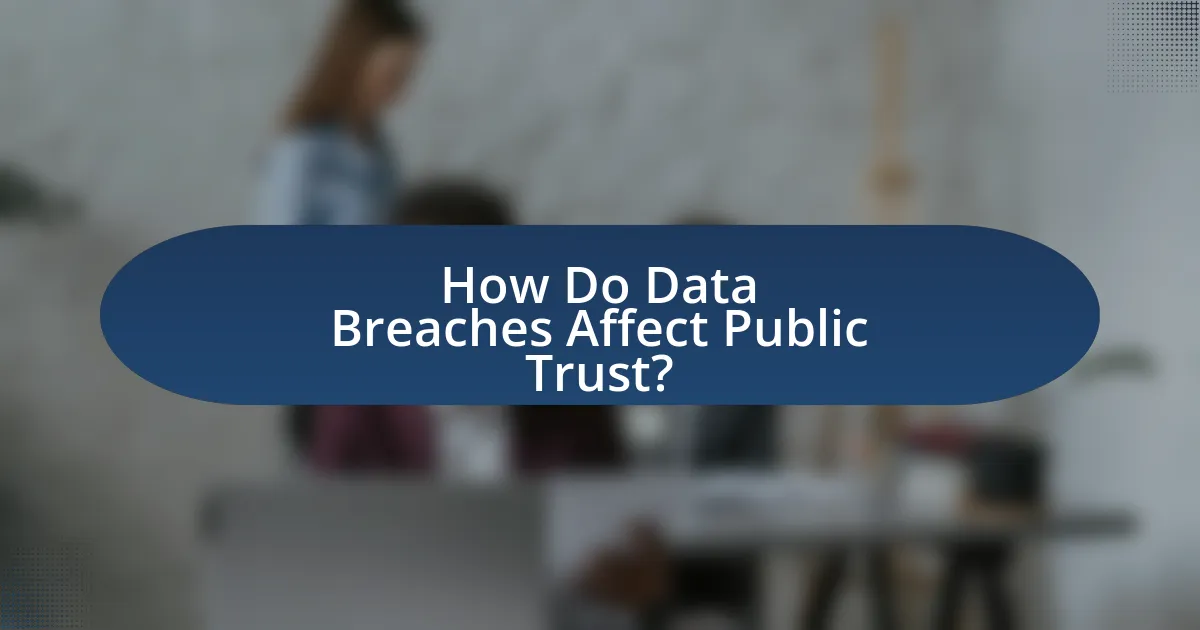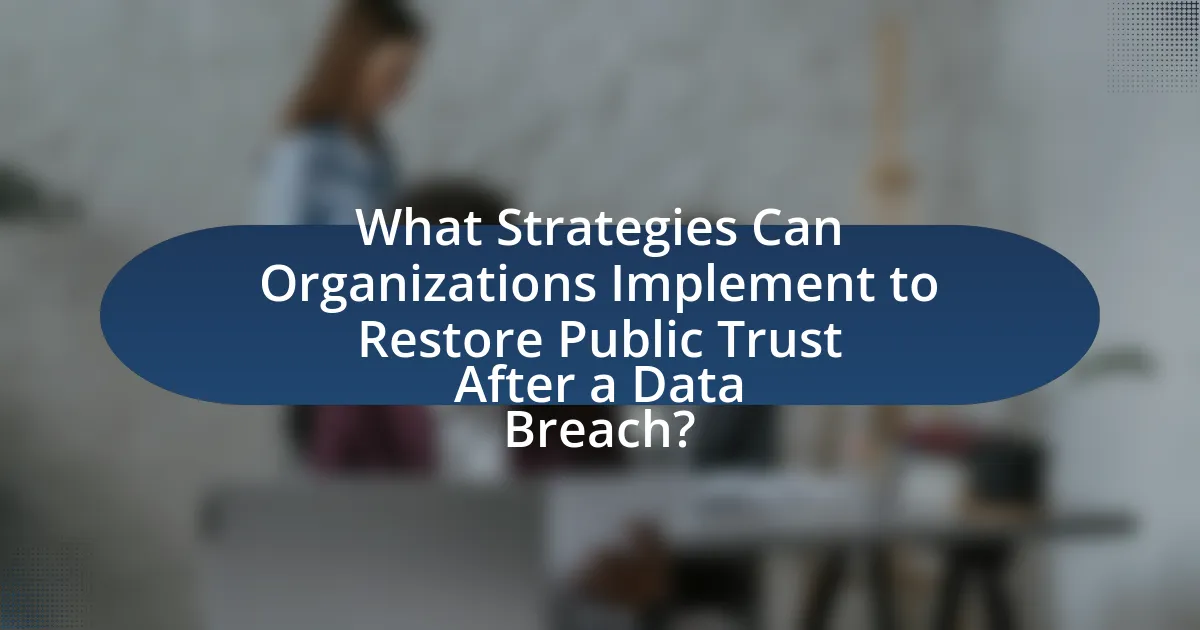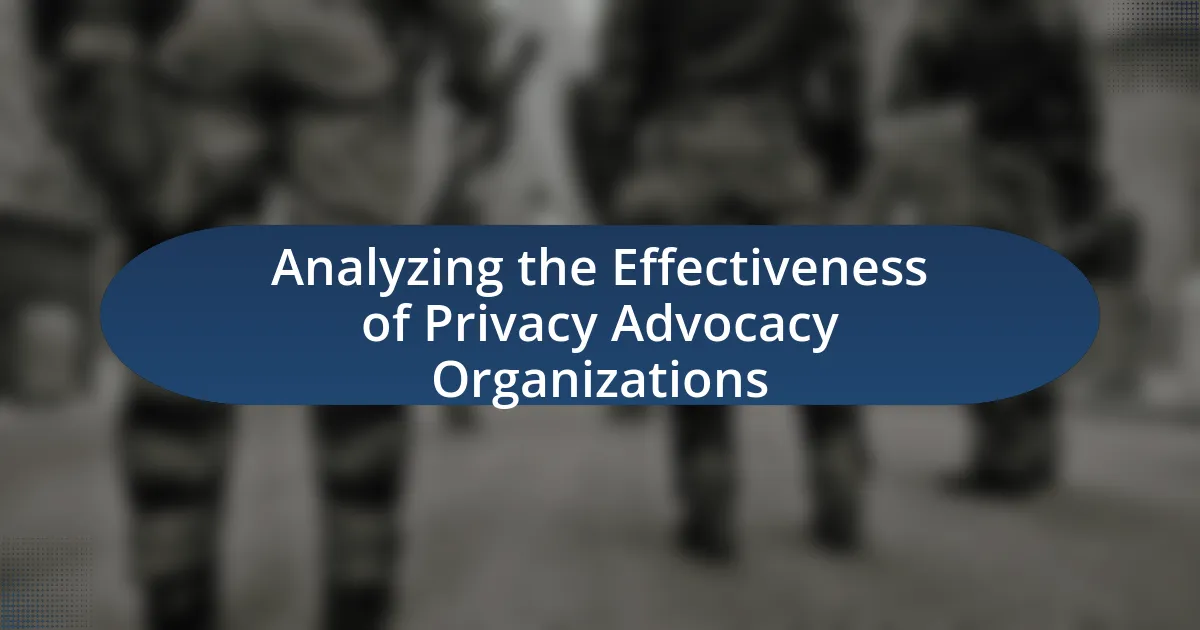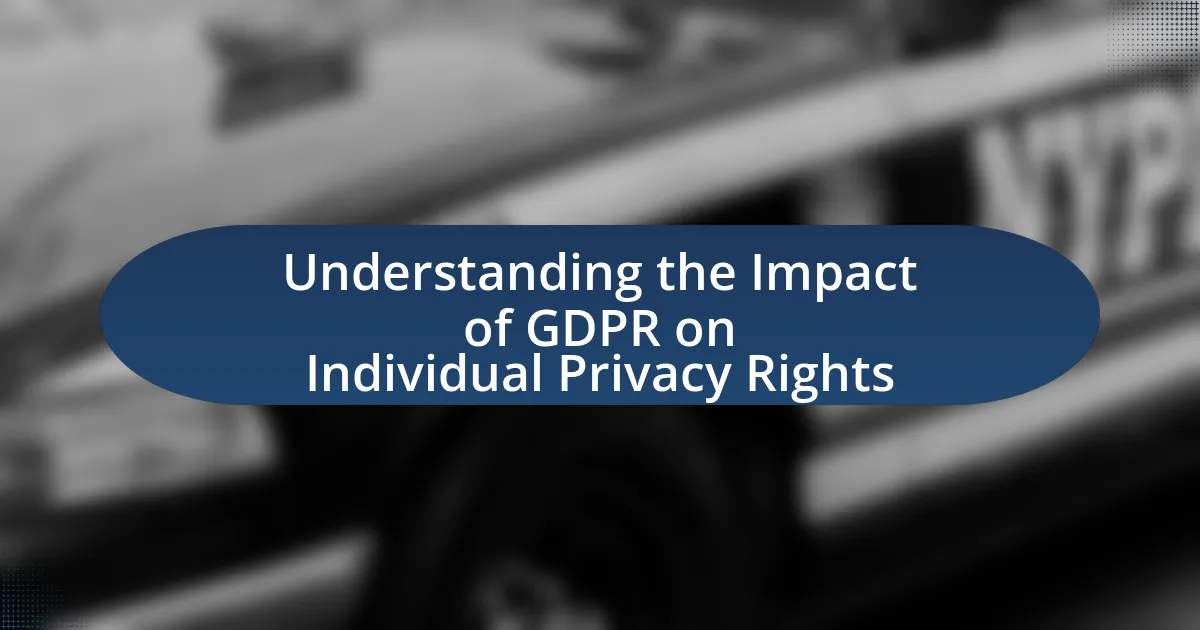Data breaches are incidents where unauthorized access to sensitive information occurs, leading to significant consequences such as financial loss, identity theft, and reputational damage for organizations. This article examines the causes and methods of data breaches, emphasizing the role of human error and cybercriminal tactics. It highlights the detrimental effects on public trust, revealing that a majority of consumers lose confidence in organizations following a breach. Furthermore, the article discusses strategies organizations can implement to restore trust, including transparent communication, enhanced security measures, and employee training, underscoring the importance of robust data protection practices in maintaining consumer confidence.

What are Data Breaches and Their Significance?
Data breaches are incidents where unauthorized individuals gain access to sensitive, protected, or confidential data, often resulting in the exposure of personal information such as social security numbers, credit card details, and health records. The significance of data breaches lies in their potential to undermine public trust in organizations, as they can lead to financial loss, identity theft, and reputational damage. For instance, the 2017 Equifax breach exposed the personal information of approximately 147 million people, highlighting the severe consequences of inadequate data protection measures and the erosion of consumer confidence in data security practices.
How do data breaches occur?
Data breaches occur when unauthorized individuals gain access to sensitive information, typically through methods such as hacking, phishing, or exploiting vulnerabilities in software. For instance, in 2020, the Verizon Data Breach Investigations Report indicated that 86% of breaches were financially motivated, often involving stolen credentials or malware. Additionally, human error, such as misconfigured databases or accidental data exposure, contributes significantly to breaches, as highlighted by the 2021 IBM Cost of a Data Breach Report, which found that 23% of breaches were due to human mistakes. These incidents compromise personal data, leading to significant impacts on public trust in organizations.
What are the common methods used by cybercriminals?
Cybercriminals commonly use methods such as phishing, malware, ransomware, and social engineering to exploit individuals and organizations. Phishing involves deceptive emails or messages that trick users into revealing sensitive information, with a report from the Anti-Phishing Working Group indicating that phishing attacks increased by 220% in 2020. Malware refers to malicious software designed to infiltrate systems, often used to steal data or disrupt operations; in 2021, the global cost of malware attacks was estimated at $6 trillion. Ransomware is a type of malware that encrypts files and demands payment for their release, with the FBI reporting that ransomware attacks rose by 300% in 2020. Social engineering manipulates individuals into divulging confidential information, with studies showing that 98% of cyberattacks rely on social engineering tactics. These methods highlight the evolving strategies employed by cybercriminals to compromise data security and public trust.
What role do human errors play in data breaches?
Human errors are a significant factor in data breaches, accounting for approximately 95% of all cybersecurity incidents. These errors can include actions such as misconfiguring security settings, falling for phishing attacks, or unintentionally exposing sensitive information. For instance, a study by the Ponemon Institute found that human error was the leading cause of data breaches in 2020, highlighting the critical role that employee actions play in compromising data security. This underscores the necessity for organizations to implement comprehensive training and awareness programs to mitigate the risks associated with human errors in data handling.
Why are data breaches a concern for organizations?
Data breaches are a concern for organizations because they can lead to significant financial losses, reputational damage, and legal repercussions. When sensitive data is compromised, organizations may face costs related to remediation, regulatory fines, and potential lawsuits. For instance, the average cost of a data breach in 2023 was estimated at $4.45 million, according to the IBM Cost of a Data Breach Report. Additionally, data breaches erode public trust, as consumers are less likely to engage with organizations that fail to protect their information, leading to long-term impacts on customer loyalty and brand integrity.
What are the potential financial impacts of a data breach?
A data breach can lead to significant financial impacts, including direct costs such as legal fees, regulatory fines, and compensation for affected customers. For instance, the average cost of a data breach in 2023 was estimated at $4.45 million, according to the IBM Cost of a Data Breach Report. Additionally, organizations may face indirect costs like loss of business, reputational damage, and increased cybersecurity investments. A study by Ponemon Institute found that companies experience an average revenue loss of 30% following a breach due to diminished customer trust and loyalty. These financial repercussions highlight the critical importance of robust data protection measures.
How can data breaches affect an organization’s reputation?
Data breaches can severely damage an organization’s reputation by eroding public trust and confidence. When sensitive customer information is compromised, it leads to negative perceptions about the organization’s ability to protect data, which can result in loss of customers and revenue. According to a 2020 study by IBM, the average cost of a data breach is $3.86 million, and organizations that experience breaches often see a significant decline in stock prices and customer loyalty. Furthermore, a survey by PwC found that 85% of consumers would not do business with a company if they had concerns about its security practices. This illustrates that data breaches not only impact immediate financial performance but also long-term brand reputation and customer relationships.

How Do Data Breaches Affect Public Trust?
Data breaches significantly undermine public trust in organizations. When sensitive information is compromised, consumers often feel vulnerable and question the security measures in place, leading to a decline in confidence. For instance, a 2020 study by the Ponemon Institute found that 75% of consumers would stop purchasing from a company after a data breach. This erosion of trust can result in long-term reputational damage and financial losses for the affected organizations, as customers seek alternatives perceived as more secure.
What is the relationship between data breaches and public trust?
Data breaches significantly undermine public trust in organizations. When sensitive information is compromised, consumers often feel vulnerable and question the security measures of the entity involved. A study by the Ponemon Institute found that 75% of consumers would stop using a company after a data breach, illustrating the direct correlation between breaches and diminished trust. Furthermore, organizations that experience data breaches often face long-term reputational damage, leading to decreased customer loyalty and financial losses. This relationship highlights the critical importance of data security in maintaining public confidence.
How do data breaches influence consumer perceptions of security?
Data breaches significantly diminish consumer perceptions of security. When consumers learn about a data breach, their trust in the affected organization declines, leading to increased skepticism about the security measures in place. For instance, a study by the Ponemon Institute found that 75% of consumers would stop using a company’s services after a data breach, indicating a direct correlation between breaches and consumer trust. Additionally, the 2021 IBM Cost of a Data Breach Report highlighted that organizations with a history of breaches face higher costs and longer recovery times, further reinforcing the negative impact on consumer confidence in their security practices.
What evidence exists linking data breaches to declines in public trust?
Data breaches significantly correlate with declines in public trust, as evidenced by various studies. For instance, a 2019 study published in the Journal of Cybersecurity found that 70% of consumers reported a loss of trust in companies following a data breach. Additionally, the Ponemon Institute’s 2020 Cost of a Data Breach Report indicated that organizations experiencing breaches saw a 3% drop in customer retention rates, directly linking data security incidents to diminished consumer confidence. These findings illustrate a clear relationship between data breaches and the erosion of public trust in organizations.
Why do consumers lose trust after a data breach?
Consumers lose trust after a data breach primarily because they feel their personal information is no longer secure. When a breach occurs, it exposes sensitive data, leading to concerns about identity theft and fraud. According to a 2020 study by the Ponemon Institute, 60% of consumers reported that they would stop doing business with a company that experienced a data breach. This statistic highlights the direct correlation between data security incidents and consumer confidence. Additionally, the lack of transparency and inadequate communication from companies during and after a breach further erodes trust, as consumers perceive negligence in protecting their data.
What psychological factors contribute to the loss of trust?
Psychological factors that contribute to the loss of trust include perceived betrayal, fear of vulnerability, and cognitive dissonance. Perceived betrayal occurs when individuals feel that their expectations of honesty and integrity have been violated, leading to a breakdown in trust. Fear of vulnerability arises when individuals recognize that their personal information is at risk, making them hesitant to engage with entities that have previously breached their trust. Cognitive dissonance occurs when individuals struggle to reconcile their previous positive beliefs about an entity with new negative information, resulting in a diminished sense of trust. Research indicates that these psychological responses are heightened in the context of data breaches, as individuals often feel exposed and uncertain about the security of their personal information.
How does the frequency of breaches impact public trust over time?
The frequency of data breaches negatively impacts public trust over time. As incidents of breaches increase, consumers become more skeptical about the security measures organizations implement to protect their personal information. Research indicates that after multiple breaches, organizations experience a significant decline in customer loyalty; for instance, a study by the Ponemon Institute found that 70% of consumers would stop doing business with a company after a data breach. This erosion of trust can lead to long-term reputational damage and financial losses for organizations, as public perception shifts towards viewing them as unreliable custodians of sensitive data.

What Strategies Can Organizations Implement to Restore Public Trust After a Data Breach?
Organizations can restore public trust after a data breach by implementing transparent communication, enhancing security measures, and providing compensation to affected individuals. Transparent communication involves promptly informing stakeholders about the breach, detailing the nature of the incident, and outlining steps taken to mitigate risks. For instance, a study by the Ponemon Institute found that 70% of consumers prefer companies that are open about data breaches. Enhancing security measures includes adopting advanced encryption technologies and conducting regular security audits to prevent future incidents. Additionally, providing compensation, such as credit monitoring services, can demonstrate accountability and commitment to customer welfare, which has been shown to improve public perception significantly.
How can transparency help rebuild trust?
Transparency can help rebuild trust by providing clear, honest communication about actions and decisions, especially following a data breach. When organizations openly share information regarding the breach, including its causes, impacts, and the steps taken to mitigate future risks, they demonstrate accountability. Research indicates that 70% of consumers are more likely to trust a company that is transparent about its data practices (Source: Edelman Trust Barometer, 2021). This openness fosters a sense of security and reassurance among stakeholders, as it shows that the organization values their trust and is committed to rectifying past mistakes.
What information should organizations disclose following a breach?
Organizations should disclose the nature of the breach, the types of data compromised, the number of affected individuals, and the steps taken to mitigate the breach. This information is crucial for transparency and helps maintain public trust. For instance, the General Data Protection Regulation (GDPR) mandates that organizations notify affected individuals within 72 hours of becoming aware of a breach, emphasizing the importance of timely and accurate disclosure. Additionally, organizations should provide information on how affected individuals can protect themselves, such as monitoring for identity theft or changing passwords. This comprehensive disclosure not only fulfills legal obligations but also fosters trust by demonstrating accountability and a commitment to data protection.
How can organizations communicate effectively with affected individuals?
Organizations can communicate effectively with affected individuals by providing timely, transparent, and accurate information regarding the data breach. This approach helps to rebuild trust and mitigate anxiety among those impacted. For instance, organizations should promptly notify affected individuals about the breach, detailing what information was compromised, the potential risks, and the steps being taken to address the situation. Research indicates that timely communication can significantly reduce negative perceptions and restore confidence; a study by the Ponemon Institute found that 70% of consumers prefer organizations to inform them about breaches quickly. Additionally, offering support resources, such as credit monitoring services, can further demonstrate commitment to the affected individuals’ well-being.
What role does improving security measures play in restoring trust?
Improving security measures plays a crucial role in restoring trust by demonstrating a commitment to protecting sensitive information. When organizations enhance their security protocols, such as implementing advanced encryption and regular security audits, they signal to stakeholders that they prioritize data protection. Research indicates that 70% of consumers are more likely to trust a company that actively communicates its security efforts, as seen in a study by the Ponemon Institute, which highlights the correlation between security investments and consumer confidence. Thus, effective security measures not only mitigate risks but also rebuild public trust following data breaches.
What best practices should organizations adopt to enhance data security?
Organizations should adopt a multi-layered approach to enhance data security, which includes implementing strong access controls, regular security audits, employee training, and data encryption. Strong access controls limit data access to authorized personnel only, reducing the risk of unauthorized access. Regular security audits help identify vulnerabilities and ensure compliance with security policies, as evidenced by a 2021 report from the Ponemon Institute, which found that organizations conducting regular audits experienced 30% fewer data breaches. Employee training raises awareness about phishing and social engineering attacks, which are responsible for 90% of data breaches according to Verizon’s 2021 Data Breach Investigations Report. Data encryption protects sensitive information both at rest and in transit, making it unreadable to unauthorized users. By implementing these best practices, organizations can significantly reduce their risk of data breaches and maintain public trust.
How can organizations demonstrate their commitment to data protection?
Organizations can demonstrate their commitment to data protection by implementing robust data security policies and practices. This includes conducting regular risk assessments, ensuring compliance with regulations such as GDPR or CCPA, and providing employee training on data privacy. For instance, a study by the Ponemon Institute found that organizations with comprehensive data protection strategies experience 50% fewer data breaches compared to those without such measures. Additionally, transparent communication with stakeholders about data handling practices and breach response plans further reinforces an organization’s dedication to safeguarding personal information.
What are the best practices for organizations to prevent data breaches and maintain public trust?
Organizations can prevent data breaches and maintain public trust by implementing robust cybersecurity measures, conducting regular security audits, and fostering a culture of security awareness among employees. Effective cybersecurity measures include using encryption, multi-factor authentication, and firewalls to protect sensitive data. Regular security audits help identify vulnerabilities and ensure compliance with industry standards, such as the General Data Protection Regulation (GDPR), which mandates strict data protection protocols. Additionally, training employees on recognizing phishing attempts and safe data handling practices significantly reduces the risk of breaches. According to a 2020 report by IBM, organizations that invest in comprehensive security training can reduce the likelihood of a data breach by up to 70%. By prioritizing these practices, organizations not only safeguard their data but also enhance their reputation and trustworthiness in the eyes of the public.
How can regular training and awareness programs help mitigate risks?
Regular training and awareness programs can significantly mitigate risks by equipping employees with the knowledge and skills necessary to recognize and respond to potential threats. These programs enhance understanding of security protocols, reducing the likelihood of human error, which is a leading cause of data breaches. For instance, a study by the Ponemon Institute found that organizations with comprehensive security awareness training experienced 70% fewer security incidents compared to those without such programs. By fostering a culture of security awareness, organizations can effectively lower their vulnerability to data breaches, thereby maintaining public trust.
What technologies can organizations implement to safeguard data?
Organizations can implement encryption, firewalls, intrusion detection systems, and multi-factor authentication to safeguard data. Encryption protects sensitive information by converting it into a coded format that can only be accessed with a decryption key, thereby ensuring confidentiality. Firewalls act as barriers between trusted internal networks and untrusted external networks, preventing unauthorized access. Intrusion detection systems monitor network traffic for suspicious activity, allowing organizations to respond quickly to potential threats. Multi-factor authentication adds an additional layer of security by requiring users to provide two or more verification factors to gain access to systems, significantly reducing the risk of unauthorized access. These technologies collectively enhance data security and help maintain public trust by protecting sensitive information from breaches.





